BY LETTER
Mars
Galactography > Regions of Space > Inner Sphere
Galactography > Other Major Polities, Empires, and Meta-Empires > Solsys Organization
Galactography > Other Major Polities, Empires, and Meta-Empires > Solsys Organization
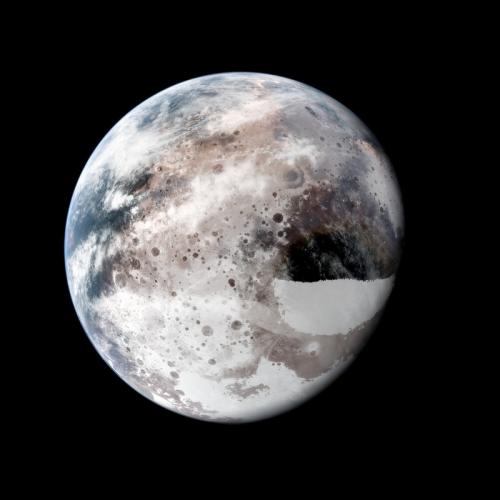 Image from Phil B | |
| Mars in 10600 A.T. Despite the slightly low atmospheric pressure, the scale height of the atmosphere is quite high, and affords a reasonably good shield against stray cosmic rays. | |
Mars - Data Panel | |
| System | Solsys |
|---|---|
| Planet | Mars, Sol IV |
| Planet Type | EuArean Subtype, partially terraformed |
| Distance from Primary | 1.52 AU |
| Diameter | 6794 km |
| Density | 3.94 gm/cm3 |
| Gravity | 0.379 G |
| Day Year | 24.6 hours / 686.98 days |
| Axial Tilt | 25.19 degrees |
| Satellites | Little remains of the original Phobos and Deimos; much of the mass of Deimos remains as an anchor for a space elevator (see below) |
| Average Surface temperature | Original: -83°C to -33°C Current: -21°C to 15°C |
| Polity Name | Republic of Mars |
| Capital | Olympia |
| Mars Flag | The 'Red-Green-Blue' |
| Affiliation | The Solsys Organisation (Fomalhaut Acquisition Society maintains influence but Mars is not a member) |
| AI overseers | Mars currently has no official AI oversight, although a number of Solsys transapient entities make their home there |
| Currency | Red Dollar |
| Territory | Mars and Martian Orbital Space |
| Population | 491 billion sophonts (93% sophtwares, 4% Martian tweaks, 1% Vecs, 1% Superiors, .5% Cyborgs, .4% nearbaselines, .1% other |
| Language | Martian (official). Solsys Org Anglish widely spoken. |
History
Pre-Technocalypse
As the second closest planet to Earth, Mars was an early target for exploration. While digital plagues later attacked the records of early Martian history, the most common conclusion reached by historians is that the first probes, launched by the United States of America, reached Mars in the last decade BT (1960s CE). Over the next several decades many more probes followed from Russia, China, India, Japan, and Europe, and possibly other nations. Most historians agree that the first successful crewed mission, consisting of the American ships Discovery and Endeavour, reached the planet in 69 AT (2038 CE) landing at Isidis and Chryse. A second crewed mission would not be launched until 94 AT (2063 CE), after which human settlement became permanent. The early years of colonization were extremely hazardous, but slowly the population increased. The first habitation to reach over a thousand citizens was Port Robinson, which eventually grew into the planet's leading city. Other early settlements included Lucky Strike, Xianhongshan, Tithonius, and Aresopolis. In 185 AT (2154 CE), the first Martian space elevator was constructed. This, and the start of regular cycler service between Mars and Earth, led to rapid development. In 224 AT (2193 CE), the Solsys' Inner Council created the Martian Union, a supranational entity designed to foster economic and political relations between the planet's growing colonies and settlements. Among its many duties, the Martian Union coordinated and facilitated the nascent terraforming research and the earliest efforts to modify the planet's environment. The various Earth nations continued to expand their territories with the United States even admitting a Martian state called New Plymouth. The European Federation eventually settled the region around the Argyre Planitia so heavily that it became known as Nova Europa, or "New Europe", with its capital at Aachen City in Hale Crater. 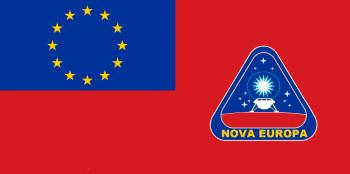 Images from NK_Ryzov, used with Permission, adapted by Arik | |
| European and Japanese colony flags, Interplanetary Age | |
 Image from Steve Bowers | |
| The Deimos anchorweight keeps a Martian Elevator in tension | |
The Technocalypse
The Technocalypse of 565-568 AT (2534-2537 CE) ravaged Mars, destroying most settlements on the surface and effectively stopping all terraforming efforts. Mars began to be seriously affected by the disaster when the Black Rot found its way to Martian territory and began to spread and disrupt the planetary ecosystem. To prevent further contamination, in 565 AT the Martian Union severed ties with the rest of the Inner Council and established an emergency government to combat the crisis. In 566 AT, the situation escalated with the arrival of the digital plagues and the neumann swarms that disrupted and damaged the planetary technological infrastructure and caused numerous casualties. Mars resorted to military escalation to deal with this threat, leading to the deployment of the protowars. The fact that Mars and other Solsys powers revealed their protowars almost simultaneously indicates a covert conflict, that most likely also included at least some of their respective transapients, that now escalated into open warfare. When the protowars rebelled, Mars was at their mercy. The ensuing war and the malicious comet bombardments of 567 AT caused the death of at least 50% of the population and a significant setback on the terraformation.Image from Anders Sandberg | |
| Comet impact 21600123-5 striking Hellas Planitia. During the Technocalypse many inbound comets, originally meant for the terraformation effort, struck outside of the intended impact zones. | |
The Dark Ages
The Solsys Dark Ages that followed proved a formative period for Martian society. Aided by the influx of Earth refugees from the Great Expulsion, the Martian population slowly began to rebuild. With the collapse of the Martian Union, new polities emerged to fill the vacuum. In 629 AT (2598 CE), a provisional government consisting of several factions established the Republic of Mars. Krisna Nur Nnamdi served as the Republic's founding leader with its first capital at Judian Station. Slowly, Republican forces began retaking the surface in a period Martians refer to as the Reclamation. Over the following decades, the Republic of Mars integrated nearly all other independent Martian polities. During this time of hardships and isolation, Mars developed an increasingly distinct culture. In an effort to promote unity, Martian, originally an English based creole that diverged from Anglish, became the world's lingua franca. Many other familiar aspects of Martican culture such as Mangalashi poetry and the boardgame Qimarte, also known as Martian Chess, developed during this time. Resource constraints and the loss of technical knowhow curtailed any terraforming efforts - the exception being the reconstruction of the artificial magnetosphere. Certain robust species, such as Aldershof's Lichen and the ubiquitous rust rats, continued to eke out an existence on and below the surface.First Federation
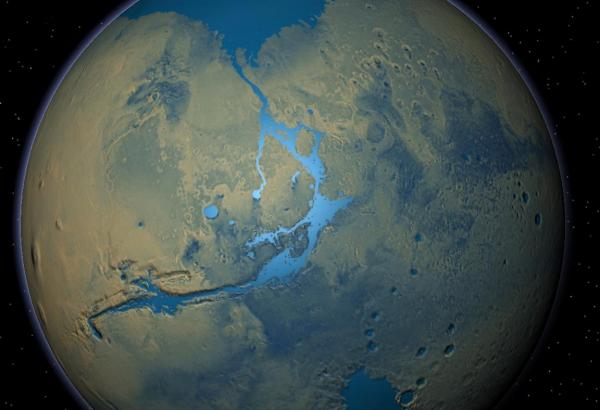 Image from Steve Bowers | |
| Mars (without clouds) during the First Federation period. | |
Second Federation
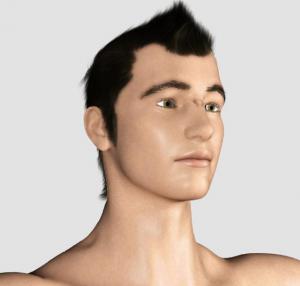 Image from Phil B | |
| A Martian tweak. These tweaks are tolerant of the high levels of carbon dioxide and low nitrogen levels found on this world. Additional nostrils at the top of the nose allow the tweak to breathe in and out in a cyclic fashion, absorbing oxygen more efficiently especially at altitude. | |
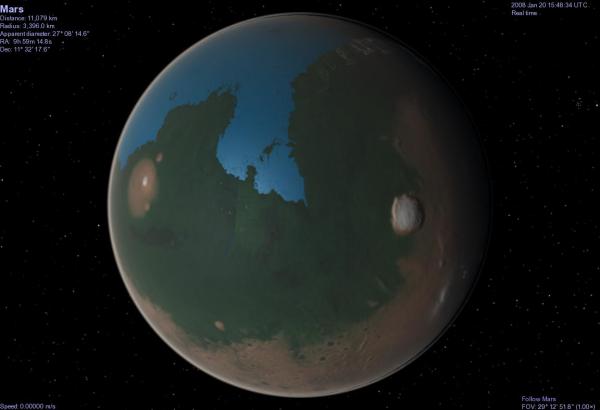 Image from Steve Bowers | |
| Mars during the Second Federation period | |
Solsys Org
The Martian Republic joined the Solsys Organization upon its creation after the fall of the Second Federation. It exercised considerably less clout than in previous millennia as the outer planets had long ago far surpassed it in population and production. Mars opened its borders to refugees during the Version War, though most left when the conflict ended. Though there were occasional spurts of dynamism, Martian society largely settled into a content conservatism focused on preserving past traditions. Citizens not wanting an embodied existence but wishing to continue some level of participation in the planetary affairs inhabited one of the many computronium nodes under the surface or in orbit. This eventually gave the Republic of Mars a relatively high percentage of virtuals compared to other terrestrial worlds in Solsys.Mars in the Current Era
Geography
Mars hosts an array of surface settlements which, besides the capital of Olympia, includes Labyrinth City, Chaos, Tharsis, Mariner City, Ius, Coprates, New Cydonia City, Zephyria, Hellas Ocean Arcology, and Airy-0. Mars makes considerable use of underground habitation with much of the population living within spacious, artificially lit caverns. This leaves large sections of the Martian countryside as either uninhabited wilderness or agricultural fields farmed by bots. Many settlements on Mars have been inhabited for thousands of years, with new habitations often built over or below earlier construction. Climate changes from terraforming have left the remains of abandoned, settlements beneath the newer oceans, while a variety of present-day wildlife preserves like the Hesperia Wildlife Refuge have covered the ruins of above-ground urban sprawl from a brief expansion in the 5800s. Many roads and transport lines across the Martian landscape have been in use continuously since their construction before the First Federation, leading to their persistent moniker as 'canals' left over from myths before the Technocolypse. Mars is currently serviced by nine beanstalks. The most used connects the re-positioned remnants of Mars' moon Deimos, now known simply as Aerostat Terminus Alpha, to Juventae Bay on the surface. Martian orbital space has several constellations of large habitats arranged at various altitudes. A station of note is Biston which houses an impressive array of museum ships. Many habitats are composed entirely of banks of computronium for sophtwares, most of which are uploads of past Martian citizens. These uploads account for the vast majority of the Republic's population.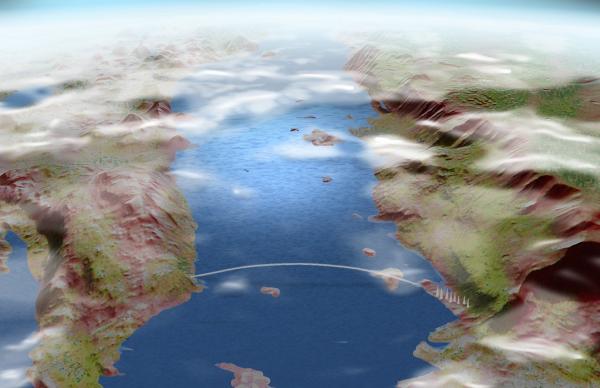 Image from Steve Bowers | |
| The Great Canyon Bridge over the Valles Marineris Sea is supported by mass-stream technology | |
Biosphere
The Martian atmosphere maintains a pressure of 700 millibars. The atmosphere has considerably less nitrogen and considerably more carbon dioxide than the atmosphere of Old Earth; unmodified baseline humans still need to use breathing apparatus or biotech adaptations to avoid CO2 poisoning. The partial pressure of oxygen on Mars is, on the other hand, comparable to that of Earth. Mars has many diverse ecosystems of gengineered life. Some animal species, such as the ubiquitous rust rats, have been around since the earliest days of terraforming. While much of Martian fauna bares some resemblances to its Earth-based ancestors, a few neogenic creatures such as the Scarlet Flyer, a feathered arthropod, possess biological features not present on Old Earth.Politics
The Republic of Mars is almost universally considered to be the oldest continually operating polity in the Terragen Sphere. While there have been numerous changes over the millennia, the basic structure of the Martian government has remained the same for thousands of years. As a parliamentary cyberdemocracy, legislative power is invested in the Senate. A distinguishing characteristic of Martian politics is the unusually high levels of modosophont participation. Mars currently has no formal transapient overseer, although many of the most powerful Solsys Organization transapients maintain a presence. Meanwhile at the modosophont level, the Solsys Organization handles most foreign affairs of the Republic of Mars. One of the most dynamic aspects of Martian society is the rise and fall of political parties, often over issues that many outsiders would deem trivial. For the last century, a three-way contest between the Old Republicans, the For the Citizens Coalition, and the All-Reds has dominated the Martian political scene. Sephirotic influences are present as well, mostly because the Fomalhaut Acquisition Society maintains considerable interest in Mars due to the abundance of antiquities.  Images from Tony Jones | |
| Select Martian Flags: Flag of the Republic of Mars (left). Flag used by the For the Citizens Coalition (right) | |
Culture
Mars boasts an ancient culture with memetic traces going back even to Old Earth. Many observers consider contemporary Martian culture as largely conservative with many restrictions regarding new construction and permanent embodied population growth. There is a heavy focus on preserving traditions and historical sites which some criticize as promoting stagnation. However, it is this penchant for history which keeps Mars a major tourist and archeology destination. The Martian calendar is packed with over 190 officially recognized holidays and commemorations including Landing Day, Declaration of the Republic, Anniversary of Resettlement, Red Day, Green Day, and Blue Day. Sporting competitions between municipalities and sub-polities are a common pastime. Mars also has the unusual distinction of maintaining a modosophont based military, the Red Militia. However, the Red Militia is almost entirely for civic and ceremonial purposes, with actual defense issues managed by the Solsys Organization. Linguistically, Martian is the official language however, Solsys standard Anglish is widely spoken.Religion
Religion and spiritual belief systems are especially prevalent on Mars compared to similarly categorized worlds in the Inner Sphere. Mars continues to host a number of faiths originating during Old Earth's Agricultural Age. Ezekiel's Wheel is a large Stanford torus in Martian orbit that serves as an important center for various Jewish groups. Certain Islamic sects believe that the Grand Mosque in Olympia is the proper place for the completion of the Haj, refusing to enter the Earth-Luna volume due to the presence of GAIA. Christianity has maintained a presence in since the earliest days of colonization with major denominations including the Reformed Catholic Church, the EOCC, and the Martian Orthodox Church. Vestiges of the pre-Technocalypse Mars Father Movement can still be found, specifically at the First Church of Father Mars in Wells Arcology. Small numbers of other religions are also found including Grek, Jovism, Solarism, and GAIAn cultists.Legacy
While Mars is of little significance outside of Solsys, it has had an important impact on Terragen development. It was the archetype for Arean worlds. As the first planet colonized and first attempted terraformation, Mars was the site of crucial lessons learned that helped begin Terragen expansion. Martians were instrumental in the colonization of certain Inner Sphere systems including Ran (Epsilon Eridani), Nesaris (Ross 154), Jinvanco (Struve 2398), and New Mars (36 Ursae Majoris). Due to its historical significance, Mars continues to feature heavily in historical and alt-historical virches. Countless locales and habitations throughout the Terragen Sphere have been named after places and people from Mars including recently Ultima Cydonia and New Nnamdi Banks Orbital in the Outer Volumes.Back to Solsys
Related Articles
- Arean Type planet
- Ares Heavy Lifting
- Earth
- Jupiter
- Lagrange Magshield, The
- Mars, Republic of
- Marsfather Movement, The
- Martian Genobiology and Mining University
- Martian Tweaks
- Martian War of Independence, The
- New Mars
- Phobos
- Pioneer Calendar
- Saturn
- Solar System in 560 AT
- Solar System in the 9th Century AT
- Solsys
- Solsys Geopolitics 2100 - 2500 CE (131 - 531 AT)
- Valparaiso Cycler
- Venus
- Weeping Wall of Satori Crater, The
Appears in Topics
Development Notes
Text by M. Alan Kazlev, MacGregor, Curtis Moore, Anders Sandberg, Tony Jones, Steve Bowers and Damon Court.
Initially published on 10 June 2000.
amended September 2016 and January 2018, rewritten january 2024 by MacGregor with contributions by Rakuen07, Worldtree, Todd Drashner
-Stories about Mars-
The Great Martian Caper
Reclamation
Traveller's Notes - Mars
Initially published on 10 June 2000.
amended September 2016 and January 2018, rewritten january 2024 by MacGregor with contributions by Rakuen07, Worldtree, Todd Drashner
-Stories about Mars-
The Great Martian Caper
Reclamation
Traveller's Notes - Mars






